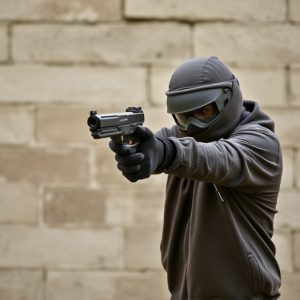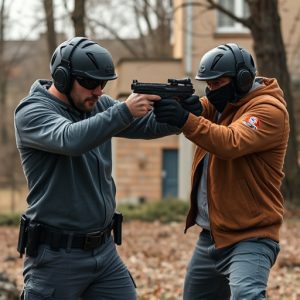Analyzing Current Patterns: Optimizing Urban Safety with Stun Guns
Understanding electrical current spread patterns is crucial for effectively using best stun guns in…….
Understanding electrical current spread patterns is crucial for effectively using best stun guns in urban settings, maximizing impact on targets while minimizing harm to bystanders. Key factors include advanced electrode configurations, compact designs, high-quality conductive materials, and controlled current discharge within 2-5 meters. Future trends focus on "smart" stun guns with adaptive technology, leveraging sensors and responsive circuitry for precise output adjustments based on target resistance, enhancing urban safety without compromising power.
“Electrical current spread patterns play a pivotal role in understanding the effectiveness of stun guns, especially in urban safety scenarios. This article delves into the intricate details of how electrical currents flow and influence stun gun performance. We explore critical factors affecting current distribution, providing insights to choose the best stun guns for urban environments.
Furthermore, we discuss safety considerations and emerging trends in stun gun design, ensuring readers are equipped with knowledge to make informed decisions regarding personal protection.”
- Understanding Electrical Current Spread Patterns
- Factors Influencing Current Flow in Stun Guns
- Choosing the Best Stun Gun for Urban Safety Based on Current Analysis
- Safety Considerations and Future Trends in Stun Gun Design
Understanding Electrical Current Spread Patterns
Understanding Electrical current spread patterns is crucial, especially in urban settings where the safe use of self-defense tools like best stun guns becomes paramount. These patterns refer to the way electrical current flows through different materials, offering insights into how energy disperses and interacts with various objects. In metal objects, for instance, current tends to follow paths of least resistance, often spreading evenly across flat surfaces and concentrating in edges or points where conductivity may vary.
This knowledge is essential when considering the effectiveness of stun guns, as understanding how current flows can help determine their reach, impact, and potential side effects on surrounding areas. In urban safety contexts, recognizing these patterns allows users to make informed decisions about deployment, ensuring minimal harm to bystanders while maximizing the stun gun’s impact on the intended target.
Factors Influencing Current Flow in Stun Guns
The flow of electrical current in stun guns is influenced by several key factors, which play a crucial role in determining their effectiveness as tools for urban safety. The design and materials used in the construction of the device significantly impact current distribution. For instance, best stun guns for urban safety often feature advanced electrode configurations that optimize current spread, ensuring a more efficient shock delivery to the target area.
Moreover, the overall size and shape of the stun gun matter. Compact and ergonomic designs can facilitate better contact with the assailant’s body, minimizing resistance and allowing for a smoother flow of current. Additionally, the use of high-quality conductive materials in the electrodes enhances current conduction, making the stun gun more reliable in real-world scenarios where quick and consistent shocks are essential for effective urban safety measures.
Choosing the Best Stun Gun for Urban Safety Based on Current Analysis
When selecting a stun gun for urban safety, understanding the spread pattern of electrical current is key. The best stun guns for urban safety are those that deliver a powerful yet controlled jolt, ensuring maximum impact while minimizing risk to bystanders and officers alike. By analyzing current flow, manufacturers can optimize the design to create a more concentrated discharge, allowing for effective neutralization in close-quarters combat without causing collateral damage.
This precise control is crucial in urban environments where spaces are often confined and crowded. A well-designed stun gun should be capable of delivering a stun at ranges typically between 2–5 meters, with the current spread pattern ensuring that energy is channeled into the target while minimizing shock to surrounding areas. Advanced models incorporate safety features like automatic shut-off mechanisms after deployment and adjustable stun intensity levels, further enhancing officer safety and control in dynamic urban settings.
Safety Considerations and Future Trends in Stun Gun Design
When considering the safety aspects of stun gun design, it’s crucial to explore how current spread patterns can impact their effectiveness and user safety. Best stun guns for urban safety should prioritize optimized current distribution to ensure a reliable stun while minimizing risks. Researchers are focusing on advanced materials and innovative designs that can control and direct electrical current more precisely, reducing the potential for collateral damage or user harm.
Future trends in stun gun technology point towards smarter, more adaptive devices. Integrating intelligent sensors and responsive circuitry could allow stun guns to adjust their output based on the target’s resistance, ensuring a safe yet powerful stun. As we move forward, these innovations aim to enhance urban safety without compromising the effectiveness of stun weapons, making them valuable tools for law enforcement and self-defense in densely populated areas.
Electrical current spread pattern analysis plays a pivotal role in enhancing the safety and effectiveness of stun guns. By understanding how current flows, we can make informed decisions when choosing the best stun guns for urban safety, ensuring optimal performance and minimal risk. Factors like contact area, voltage, and pulse width significantly influence current flow, making it crucial to consider these aspects during design and selection. Safety considerations and future trends in stun gun design must prioritize user safety and efficiency, leveraging technological advancements to create more reliable and effective tools for urban security.


